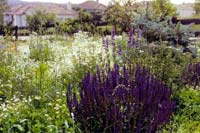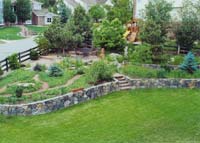Why Landscape For Nature?
If you enjoy observing nature and have suitable property, then you have the ability to experience the many diverse and wondrous events and activities Mother Nature has in store for us. Outside the obvious pleasure wildlife can bring to you, consider these compelling reasons to create a natural habitat for nature on your property.
Photography And Wildlife Watching
With careful planning you can bring a wide variety of birds and other wildlife species within easy viewing. Bird nesting boxes, fruiting plants, nectar flowers, and water sources can all be placed in a beautiful natural landscape that can be easily seen from a favorite window. Many birds, butterflies, and native pollinators will be attracted to a wildflower meadow. A pond or wetland area will provide a home to fish, frogs, and other beneficial creatures. Variety in your landscaping will mean variety in your photographs, sketches or what you see through your binoculars.
Let nature put on a show while you relax on the back porch.
Education
And therapy involving your children will make them more aware of nature and will help educate them about the needs and preferences of different wildlife species. It will provide a fantastic bonding experience between adult and child as Mother Nature works her miracles of life in your backyard natural classroom. Your children will acquire a deep respect for life and an early appreciation for conservation.
Native landscaping also can provide great personal satisfaction and therapy for someone with a disability in your family.
Lawn Maintenance
In many cases, care for lawns in this country, especially the western region, requires large quantities of water and chemicals. These requirements are non-beneficial and even harmful for birds and other wildlife. Pesticides seep into the watershed and the space reserved for lawns displaces plants which otherwise would provide food and cover for wildlife.
While there is a definite need for lawns in suburban family life, consideration should be given to just how much you actually need. A good plan for your property would aesthetically blend the grass lawn needed for your child’s playground and the backyard natural habitat reserved for birds and other wildlife.
Economic
A pleasing, unique landscape will increase the overall value of your home. Studies show this can be as much as 20 percent. In addition, you will save on mowing, fertilizing, and watering.
Energy Conservation
Trees and shrubbery provide shade and block winds. Proper placement will lower your energy bill as well as provide food and shelter for wildlife.
Soil Conservation
Everything you grow depends on how fertile the soil is. Planting native plants will improve the fertility of the soil because their root systems can penetrate even tough, compacted clay.
Natural Beauty
No one can argue the beauty of a wildflower meadow or fruit-producing trees and shrubs. At the same time, these habitat-friendly plants provide shelter, cover, and a food source for birds and a variety of wildlife.
Natural Insect Control
Wildlife such as birds and bats are a great benefit to controlling insect populations. A single bat will consume one half its body weight each evening in mosquitoes, beetles, and moths. Many birds such as Tree Swallows consume large numbers of insect pests that are harmful to trees, plants, and people.
Food Production
Plants from your garden and backyard natural habitat are beneficial to both you and wildlife. There are many examples of mutual benefits. For instance, bronze fennel looks lovely in the herb garden, and also provides a host plant for Swallowtail butterfly caterpillars. Additionally, if you plant fruit trees and shrubs and provide a water source, you will attract birds and toads. They will show their gratitude by eating many of the non-beneficial insects in your garden and yard.
Pollution Control
Plants of all kinds help purify the air by removing carbon dioxide and other pollutants and they release oxygen. Many native plants enrich and aerate the soil and help other things to flourish without the need for fertilizer.
Biodiversity
The more diverse the plants you place on your property, the wider the range of wildlife that will survive there. By planting native species you will protect the genetic diversity of the area by making sure these plants continue to reproduce despite the encroachment of many alien species.
A very good resource for local backyard habitats can also be found at National Audubon. Their Audubon At Home program specifically targets those who want to establish more wildlife friendly properties. You can contact them at www.audubon.org






